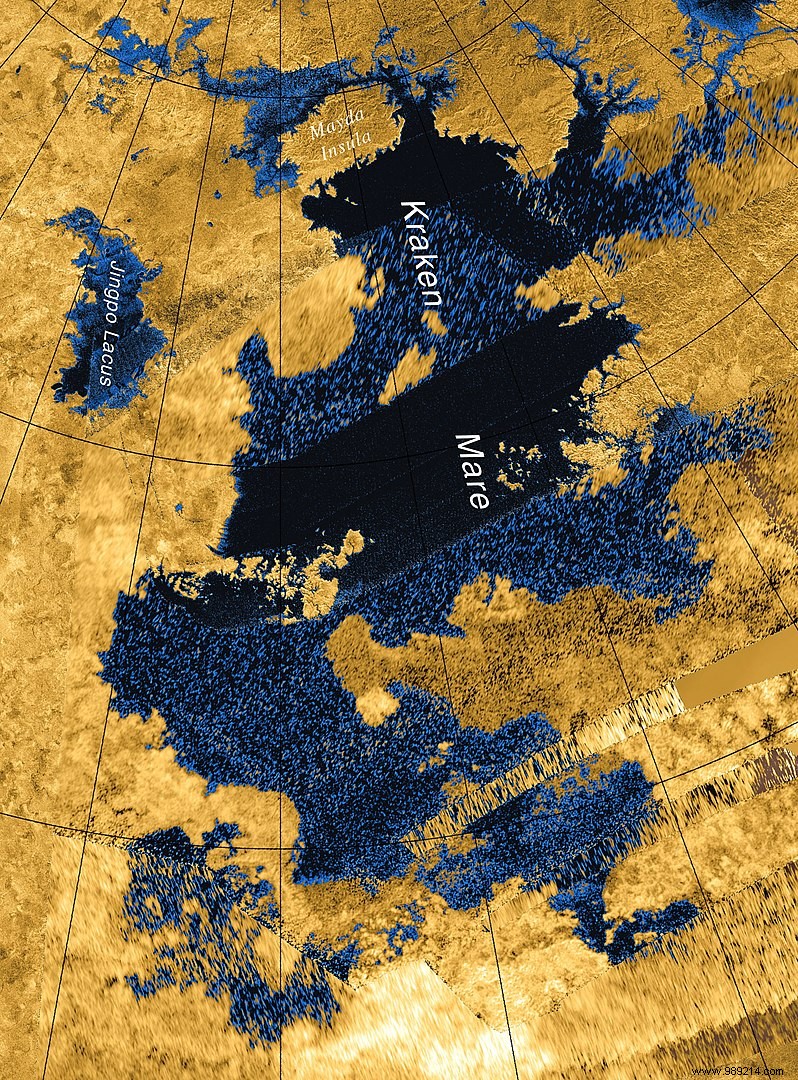Kraken Mare, a sea of liquid methane found on Titan ( Saturn's moon), would have a depth of at least one hundred meters at the center, according to an analysis of data collected by the Cassini probe in 2014.
At 5150 kilometers wide, Titan is the second largest moon in the Solar System, just behind Ganymede. Apart from our planet, it is the only body in the Solar System that has stable liquids on the surface. A billion kilometers from the Earth, under its thick golden envelope composed mainly of gaseous nitrogen, there is indeed a landscape of almost terrestrial appearance with rivers, lakes and seas of methane and ethane in liquid form. .
Present in the Saturn system between 2004 and 2017, the Cassini mission made it possible to estimate the depth and composition of each of Titan's seas, with the exception of Kraken Mare, the largest which contains about 80% of the surface liquids of the moon . It is now done, at least indirectly.
In a recent study, researchers at Cornell University sifted through data from one of the last flybys (T104) of Titan by the mission Cassini, operated on August 21, 2014. The probe was then placed at just over 900 km above the surface of Titan, speeding at nearly 20,000 km/h.
During this flyby, Cassini had deployed its radar altimeter to measure liquid depth (bathymetry) at Kraken Mare and Moray Sinus, an estuary located at the northern end of the great For the researchers, the idea was basically to note the differences in radar return time between the liquid surface and the bottom of the sea. It was also possible to estimate its composition by highlighting the amount of radar energy absorbed during transit through the liquid.
This work made it possible to estimate the depth of Moray Sinus:about 85 meters . According to the absorption of radar waves, this estuary is composed of 70% methane, 16% nitrogen and 14% ethane.
Analysis of altimeter data in the main body of Kraken Mare, on the other hand, showed no evidence of signals returning from the seafloor, suggesting that the liquid is either too deep or too absorbing for Cassini's radio waves to penetrate. However, assuming that Kraken Mare's composition is similar to that of Moray Sinus, as you would expect, the researchers estimated that its depth could reach 300 meters at its center. .

There would therefore be plenty of room for a potential robotic submarine to explore this gigantic sea, as large as the five Great Lakes combined (about 400,000 square kilometers ). Moreover, that's good:researchers are currently working on the development of a project in this direction. If approved by NASA, such a mission could be launched in the 2030s with an expected arrival in the 2040s .
Among the scientific equipment possibly on board, the researchers mention instruments capable of analyzing the chemistry of hydrocarbons, a surface imager, a depth sounder and a weather station. Additional instruments could also analyze seafloor samples.
A mission of this type could then teach us more about this incredible moon which, according to many astrobiologists, could harbor life. If indeed it exists, it would be very different from the one evolving on Earth.